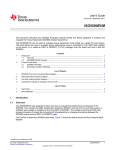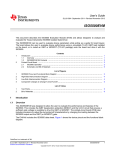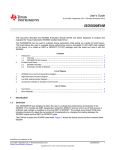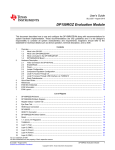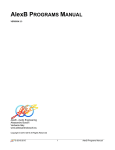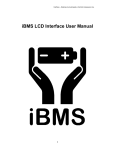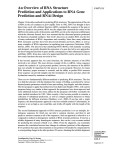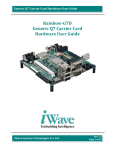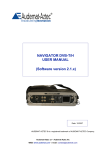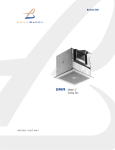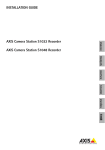Download ISO5500EVM User`s Manual (Rev. A)
Transcript
User's Guide SLLU136A – September 2011 – Revised November 2012 ISO5500EVM This document describes the ISO5500 Evaluation Module (EVM) and allows designers to analyze and evaluate the Texas Instruments ISO5500 Isolated Gate Driver. The ISO5500EVM can be used to evaluate device parameters while acting as a guide for board layout. The board allows the user to evaluate device performance using a simulated (10-nF) IGBT load installed on the board, or to install an IGBT or MOSFET (TO-247 package) onto the board and drive it with the ISO5500. 1 2 Contents Introduction .................................................................................................................. 1.1 Overview ............................................................................................................ 1.2 ISO5500EVM Kit Contents ....................................................................................... Printed-Circuit Board ....................................................................................................... 2.1 ISO5500 Operation ................................................................................................ 2.2 Schematic and Bill of Materials .................................................................................. 1 1 2 2 2 5 List of Figures 1 2 3 4 ........................................................................ High-Side Interconnection Diagram ...................................................................................... Low-Side Interconnection Diagram ....................................................................................... Component Changes to Change Turnon/Turnoff ....................................................................... ISO5500 Pinout and Functional Block Diagram 2 4 4 5 List of Tables 1 Test Points ................................................................................................................... 5 2 Bill of Materials .............................................................................................................. 6 1 Introduction 1.1 Overview This ISO5500EVM was designed to allow the user to evaluate the performance and features of the ISO5500. This includes the IGBT desaturation protection (DESAT) and the UVLO circuit that ensures a sufficient gate voltage is available to drive the IGBT or MOSFET. The printed-circuit board (PCB) also includes provisions to adjust the turnon/turnoff characteristics by changing the loading between the ISO5500 output and the IGBT (or MOSFET) gate. The EVM kit includes the ISO5500 data sheet. Figure 1 shows the device pinout and the functional block diagram. QuietZone is a trademark of 3M. SLLU136A – September 2011 – Revised November 2012 Submit Documentation Feedback Copyright © 2011–2012, Texas Instruments Incorporated ISO5500EVM 1 Printed-Circuit Board www.ti.com DEVICE PINOUT 1 2 3 4 5 6 7 8 VIN+ VE VIN- VEE VCC1 16 15 14 DESAT VCC2 13 VC 12 VOUT 11 NC VEE 10 GND1 VEE 9 GND1 RESET FAULT Figure 1. ISO5500 Pinout and Functional Block Diagram 1.2 ISO5500EVM Kit Contents • • • 2 ISO5500EVM printed-circuit board with ISO5500DW installed (P/N 6512405) ISO5500EVM User’s Guide (This document) ISO5500 data sheet Printed-Circuit Board The ISO5500 is an isolated gate driver with several important features. The printed-circuit board (PCB) has been designed to support this device and to allow the user to evaluate its basic operation and features. The left side of the PCB contains the interface to the input, control, and status functions of the integrated circuit (IC). The right side of the PCB has been designed to interface to an IGBT (or MOSFET). No electrical connections exist between the right and left sides of the PCB. Refer to the ISO5500EVM schematic and bill of materials to become familiar with the PCB components and layout. The PCB files (Gerber/ODB) are available from Texas Instruments on request. 2.1 ISO5500 Operation 2.1.1 Left-Side Operation: DC Power, Control, and Status 2.1.1.1 DC Power The left side of the ISO5500 (and therefore the PCB) can be operated using either a +3.3-V (±10%) or +5V (±10%) dc power supply. The small amount of dc current required (<20 mA) means that the device can also be battery operated. The dc power supply must be connected to TP10 (+5 Vdc) and TP9 (+5-Vdc return). Also, a user can solder wires directly to the PCB from the dc power supply by means of the plated through-holes located next to the test points. 2.1.1.2 Control and Status The interface to the device is via the JMP1 header. It contains the VIN+ and VIN– inputs, the device RESET, and FAULT indicator output. The JMP1 header allows easy connections to test equipment using standard clip leads or QuietZone™ connectors. Each of the four signals also has a test point for additional connections. These are TP1 through TP4. 2 ISO5500EVM SLLU136A – September 2011 – Revised November 2012 Submit Documentation Feedback Copyright © 2011–2012, Texas Instruments Incorporated Printed-Circuit Board www.ti.com 2.1.2 Right-Side Operation 2.1.2.1 DC Power Power is provided to Vcc2 on the right side of the device at TP12 (+Vdc) and TP11 (–Vdc). The dc supply must be able to provide a bias voltage over the range of +15 Vdc to +30 Vdc. As the current requirement is extremely low, the user may choose to operate the ISO5500 by battery. Solder holes are provided next to the test points if the user chooses to hardwire these connections. If a negative gate drive is required, a dc supply (or battery) must be connected across VE (P5 or MFG1) to VEE (MGF11 or TP11). The voltage range must be between 0 V and 15 Vdc. 2.1.2.2 DESAT – JMP2 One of the features of the ISO5500 is the IGBT desaturation protection. JMP2 provides access to the DESAT pin. It is a 2-pin male header, and installing a shorting jumper onto JMP2 disables the DESAT function. 2.1.2.3 IGBT (or MOSFET) As shipped, the ISO5500EVM does not have an IGBT installed. The user can evaluate device operation using a simulated IGBT load or they can remove the simulated load and install an IGBT onto the board. Most IGBTs are available in the standard TO-247 package. The PCB has provisions to solder an IGBT directly onto the board. 2.1.2.3.1 No IGBT (or MOSFET) Installed – JMP3 When using the simulated load, the user must install a jumper short onto JMP3. This connects a 10-nF capacitor (C9) to the Vout pin. The simulated IGBT consists of the 10-Ω gate resistor (R4) and this 10-nF capacitor (C9). 2.1.2.3.2 IGBT (or MOSFET) Installed – REMOVE JMP3 If the user chooses to install an IGBT, JMP must be left open with no shorting jumper installed. The PCB has been designed with several large plated-through holes (or vias) to support both high-side and low-side drive configurations. (Note: Plated-through holes are designated as MFGx on the schematic.) The connections for these modes are described next. 2.1.2.3.3 High-Side/Low-Side Operation and Interconnection The connections required for high-side and low-side operation are shown in Figure 2 and Figure 3, respectively. The user can select the load and install it directly on the PCB. SLLU136A – September 2011 – Revised November 2012 Submit Documentation Feedback Copyright © 2011–2012, Texas Instruments Incorporated ISO5500EVM 3 Printed-Circuit Board www.ti.com SCHEMATIC PCB CONNECTIONS P5 Banana-Jack +HV +HV RETURN CONNECTED TO MFG5 MFG5 VE D MFG1 MFG3 SOURCE G MFG2 LOAD MFG4 DRAIN S MFG6 GATE LOAD Q1 +HV CONNECTED TO P6 OR MFG2 P6 Banana-Jack Figure 2. High-Side Interconnection Diagram PCB CONNECTIONS SCHEMATIC P5 Banana-Jack +HV VE +HV RETURN CONNECTED TO P5 OR MFG1 MFG5 LOAD D MFG1 MFG3 MFG2 MFG4 SOURCE G DRAIN LOAD MFG6 GATE S Q1 +HV CONNECTED TO MFG6 P6 Banana-Jack Figure 3. Low-Side Interconnection Diagram 2.1.2.4 Turnon/Turnoff Adjust The PCB contains a single, 10-Ω gate resistor (R4) and a short bus wire in place of diode D2. This simple configuration sets the peak current at approximately 3 A, with turnon/ turnoff characteristics the same. The PCB has provisions for the user to install the D2 and D3 diodes and R4 and R5 resistors. This allows the user to evaluate device operation with different on/off characteristics. This is shown in Figure 4. The turnon characteristics can also be adjusted with the value of R2, which connects VC to VCC2. As shipped, R2 is set to 0 Ω, but the user can change this and examine the effects on turnon characteristics. 4 ISO5500EVM SLLU136A – September 2011 – Revised November 2012 Submit Documentation Feedback Copyright © 2011–2012, Texas Instruments Incorporated Printed-Circuit Board www.ti.com Turnon/Turnoff The Same To Change Turnon and Turnoff R4 D2 D3 R5 R4 D2 D3 R5 (As Shipped) Figure 4. Component Changes to Change Turnon/Turnoff 2.1.2.5 The Interchange Jumper – JMP8 The ISO5500 device is similar to other devices currently available from other manufacturers. One of the similar devices uses pin 15 as an output driver for an LED. The TI ISO5500 uses pin 15 as a VEE (GND) connection. If the user wishes to install a different device onto the PCB, and that device does not use pin 15 as a VEE connection, the user can simply use the jumper short from JMP8. This opens the pin 15 connection to VEE. JMP8 can then be used as a test point for the output signal on pin 15. 2.1.3 Test Points Test points have been provided for ready access to signal monitoring. They are listed in Table 1. Table 1. Test Points 2.2 TEST POINT I/O TP1 Output TP2 TP3 FUNCTION FAULT PIN (Left side) Input RESET (Left side) Input VIN– (Left side) TP4 Input VIN+ (Left side) TP5 Output VOUT (Right Side) TP6 Output GATE VOLTAGE (Right Side) TP7 Input DRAIN VOLTAGE (Right Side) TP8 Input DESAT VOLTAGE (Right Side) TP9 Output GND1 (Left side) TP10 Input VCC1 (Left side) TP11 Output VEE (Right Side) TP12 Input VCC2 (Right Side) TP13 Input VE (Right Side) Schematic and Bill of Materials The ISO5500EVM schematic follows the bill of materials. SLLU136A – September 2011 – Revised November 2012 Submit Documentation Feedback Copyright © 2011–2012, Texas Instruments Incorporated ISO5500EVM 5 Printed-Circuit Board www.ti.com Table 2. Bill of Materials 6 Item Qty Reference Value Manufacturer Manufacturer Part No 1 1 C1 68 µF AVX TPSE686K020R0150 2 1 C2 10 µF AVX TPSB106K020R1000 3 1 C3 1 µF AVX TPSA105K020R3000 4 1 C4 0.1 µF GARRETT X7R0805HTTD104K 5 2 C5,C13 0.01 µF KEMET C0805C103M5RACTU 6 1 C6 330 pF KEMET C0805C331J5GACTU 7 2 C7,C14 0.1 µF KEMET C0805C104K5RACTU 8 1 C8 100 pF KEMET C0805C101J5GACTU 9 1 C9 10 nF KEMET C0805C103K1RAC3123 10 1 C10 10 µF TAIYO-YUDEN UMK325BJ106MM-T 11 1 C11 1 µF PANASONIC ECQ-V1J105JM 12 1 C12 0.1 µF KEMET C0805C104M5RACTU 13 2 C15,C16 4.7 µF VISHAY SPRAGUE TR3D475K050C0300 14 1 C17 68 µF United Chemicon EMVY500ADA680MHZ0G 15 1 D1 UF4007 VISHAY UF4007 16 1 D2 DNI - UF4007 16 AWG Wire Short 16 AWG Wire Short 17 1 D3 DNI - UF4007 VISHAY UF4007 18 1 JMP1 HDR_THVT_2x4_100M Sullins S1032-04-ND 19 7 JMP2,JMP3,JMP4,JMP5,JMP6,JMP7,JMP8 HDR_THVT_1x2 Sullins S1032-02-ND 20 10 MFG1,MFG2,MFG3,MFG4,MFG5,MFG6,MFG9,MFG 10,MFG11,MFG12 MFG060_PTH Plated Through Holes 0.060" Holes for Customer Use Only 21 2 P5,P6 Banana-Jack ITT-POMONA 3267 22 1 Q1 POWER FET DNI DNI 23 1 R1 3.3K VISHAY CRCW0805332FKEF 24 1 R2 0 Panasonic ERJ-6GEY0R00V 25 1 R3 100 Panasonic ERJ-6GEY101V 26 1 R4 10 Panasonic ERJ-1TYF100U 27 1 R5 DNI - 10 Panasonic ERJ-1TYF100U 28 9 TP1,TP2,TP3,TP4,TP5,TP6,TP7,TP8,TP13 Test Loop - Black Component Corporation TP-105-40-00 29 2 TP9,TP11 Test Loop - Black KEYSTONE 5011 30 2 TP10,TP12 Test Loop - RED KEYSTONE 5010 31 1 U1 ISO5500 Texas Instruments ISO5500 32 4 Bottom Side as shown on Bottom Side Silkscreen Bumpon Hemisphere - Black 3M SJ-5003 33 5 To Be Installed on JMP4–JMP7 Jumper Shorts With Handle TYCO 2-881545-2 ISO5500EVM SLLU136A – September 2011 – Revised November 2012 Submit Documentation Feedback Copyright © 2011–2012, Texas Instruments Incorporated Printed-Circuit Board www.ti.com Table 2. Bill of Materials (continued) Item Qty Reference Value Manufacturer Manufacturer Part No NOTE ASSEMBLY INSTRUCTIONS BELOW: INSTALL JUMPER SHORTS (ITEM 33) ONTO THE FOLLOWING JUMPER LOCATIONS: JMP1-3 TO JMP1-4 JMP1-5 TO JMP1-6 JMP2 JMP8 JMP9 INSTALL #16AWG WIRE IN PLACE OF D2 SLLU136A – September 2011 – Revised November 2012 Submit Documentation Feedback ISO5500EVM Copyright © 2011–2012, Texas Instruments Incorporated 7 Printed-Circuit Board www.ti.com SPACER - TO DELETE BLANK PAGE BEFORE THE IMPORTANT NOTICE 8 ISO5500EVM SLLU136A – September 2011 – Revised November 2012 Submit Documentation Feedback Copyright © 2011–2012, Texas Instruments Incorporated Evaluation Board/Kit Important Notice Texas Instruments (TI) provides the enclosed product(s) under the following conditions: This evaluation board/kit is intended for use for ENGINEERING DEVELOPMENT, DEMONSTRATION, OR EVALUATION PURPOSES ONLY and is not considered by TI to be a finished end-product fit for general consumer use. Persons handling the product(s) must have electronics training and observe good engineering practice standards. As such, the goods being provided are not intended to be complete in terms of required design-, marketing-, and/or manufacturing-related protective considerations, including product safety and environmental measures typically found in end products that incorporate such semiconductor components or circuit boards. This evaluation board/kit does not fall within the scope of the European Union directives regarding electromagnetic compatibility, restricted substances (RoHS), recycling (WEEE), FCC, CE or UL, and therefore may not meet the technical requirements of these directives or other related directives. Should this evaluation board/kit not meet the specifications indicated in the User’s Guide, the board/kit may be returned within 30 days from the date of delivery for a full refund. THE FOREGOING WARRANTY IS THE EXCLUSIVE WARRANTY MADE BY SELLER TO BUYER AND IS IN LIEU OF ALL OTHER WARRANTIES, EXPRESSED, IMPLIED, OR STATUTORY, INCLUDING ANY WARRANTY OF MERCHANTABILITY OR FITNESS FOR ANY PARTICULAR PURPOSE. The user assumes all responsibility and liability for proper and safe handling of the goods. Further, the user indemnifies TI from all claims arising from the handling or use of the goods. Due to the open construction of the product, it is the user’s responsibility to take any and all appropriate precautions with regard to electrostatic discharge. EXCEPT TO THE EXTENT OF THE INDEMNITY SET FORTH ABOVE, NEITHER PARTY SHALL BE LIABLE TO THE OTHER FOR ANY INDIRECT, SPECIAL, INCIDENTAL, OR CONSEQUENTIAL DAMAGES. TI currently deals with a variety of customers for products, and therefore our arrangement with the user is not exclusive. TI assumes no liability for applications assistance, customer product design, software performance, or infringement of patents or services described herein. Please read the User’s Guide and, specifically, the Warnings and Restrictions notice in the User’s Guide prior to handling the product. This notice contains important safety information about temperatures and voltages. For additional information on TI’s environmental and/or safety programs, please contact the TI application engineer or visit www.ti.com/esh. No license is granted under any patent right or other intellectual property right of TI covering or relating to any machine, process, or combination in which such TI products or services might be or are used. FCC Warning This evaluation board/kit is intended for use for ENGINEERING DEVELOPMENT, DEMONSTRATION, OR EVALUATION PURPOSES ONLY and is not considered by TI to be a finished end-product fit for general consumer use. It generates, uses, and can radiate radio frequency energy and has not been tested for compliance with the limits of computing devices pursuant to part 15 of FCC rules, which are designed to provide reasonable protection against radio frequency interference. Operation of this equipment in other environments may cause interference with radio communications, in which case the user at his own expense will be required to take whatever measures may be required to correct this interference. EVM Warnings and Restrictions It is important to operate this EVM within the input voltage range of 3.3 V to 5 V and the output voltage range of 10 V to 30 V . Exceeding the specified input range may cause unexpected operation and/or irreversible damage to the EVM. If there are questions concerning the input range, please contact a TI field representative prior to connecting the input power. Applying loads outside of the specified output range may result in unintended operation and/or possible permanent damage to the EVM. Please consult the EVM User's Guide prior to connecting any load to the EVM output. If there is uncertainty as to the load specification, please contact a TI field representative. During normal operation, some circuit components may have case temperatures greater than 80° C. The EVM is designed to operate properly with certain components above 80° C as long as the input and output ranges are maintained. These components include but are not limited to linear regulators, switching transistors, pass transistors, and current sense resistors. These types of devices can be identified using the EVM schematic located in the EVM User's Guide. When placing measurement probes near these devices during operation, please be aware that these devices may be very warm to the touch. Mailing Address: Texas Instruments, Post Office Box 655303, Dallas, Texas 75265 Copyright © 2012, Texas Instruments Incorporated IMPORTANT NOTICE Texas Instruments Incorporated and its subsidiaries (TI) reserve the right to make corrections, enhancements, improvements and other changes to its semiconductor products and services per JESD46, latest issue, and to discontinue any product or service per JESD48, latest issue. Buyers should obtain the latest relevant information before placing orders and should verify that such information is current and complete. All semiconductor products (also referred to herein as “components”) are sold subject to TI’s terms and conditions of sale supplied at the time of order acknowledgment. TI warrants performance of its components to the specifications applicable at the time of sale, in accordance with the warranty in TI’s terms and conditions of sale of semiconductor products. Testing and other quality control techniques are used to the extent TI deems necessary to support this warranty. Except where mandated by applicable law, testing of all parameters of each component is not necessarily performed. TI assumes no liability for applications assistance or the design of Buyers’ products. Buyers are responsible for their products and applications using TI components. To minimize the risks associated with Buyers’ products and applications, Buyers should provide adequate design and operating safeguards. TI does not warrant or represent that any license, either express or implied, is granted under any patent right, copyright, mask work right, or other intellectual property right relating to any combination, machine, or process in which TI components or services are used. Information published by TI regarding third-party products or services does not constitute a license to use such products or services or a warranty or endorsement thereof. Use of such information may require a license from a third party under the patents or other intellectual property of the third party, or a license from TI under the patents or other intellectual property of TI. Reproduction of significant portions of TI information in TI data books or data sheets is permissible only if reproduction is without alteration and is accompanied by all associated warranties, conditions, limitations, and notices. TI is not responsible or liable for such altered documentation. Information of third parties may be subject to additional restrictions. Resale of TI components or services with statements different from or beyond the parameters stated by TI for that component or service voids all express and any implied warranties for the associated TI component or service and is an unfair and deceptive business practice. TI is not responsible or liable for any such statements. Buyer acknowledges and agrees that it is solely responsible for compliance with all legal, regulatory and safety-related requirements concerning its products, and any use of TI components in its applications, notwithstanding any applications-related information or support that may be provided by TI. Buyer represents and agrees that it has all the necessary expertise to create and implement safeguards which anticipate dangerous consequences of failures, monitor failures and their consequences, lessen the likelihood of failures that might cause harm and take appropriate remedial actions. Buyer will fully indemnify TI and its representatives against any damages arising out of the use of any TI components in safety-critical applications. In some cases, TI components may be promoted specifically to facilitate safety-related applications. With such components, TI’s goal is to help enable customers to design and create their own end-product solutions that meet applicable functional safety standards and requirements. Nonetheless, such components are subject to these terms. No TI components are authorized for use in FDA Class III (or similar life-critical medical equipment) unless authorized officers of the parties have executed a special agreement specifically governing such use. Only those TI components which TI has specifically designated as military grade or “enhanced plastic” are designed and intended for use in military/aerospace applications or environments. Buyer acknowledges and agrees that any military or aerospace use of TI components which have not been so designated is solely at the Buyer's risk, and that Buyer is solely responsible for compliance with all legal and regulatory requirements in connection with such use. TI has specifically designated certain components which meet ISO/TS16949 requirements, mainly for automotive use. Components which have not been so designated are neither designed nor intended for automotive use; and TI will not be responsible for any failure of such components to meet such requirements. Products Applications Audio www.ti.com/audio Automotive and Transportation www.ti.com/automotive Amplifiers amplifier.ti.com Communications and Telecom www.ti.com/communications Data Converters dataconverter.ti.com Computers and Peripherals www.ti.com/computers DLP® Products www.dlp.com Consumer Electronics www.ti.com/consumer-apps DSP dsp.ti.com Energy and Lighting www.ti.com/energy Clocks and Timers www.ti.com/clocks Industrial www.ti.com/industrial Interface interface.ti.com Medical www.ti.com/medical Logic logic.ti.com Security www.ti.com/security Power Mgmt power.ti.com Space, Avionics and Defense www.ti.com/space-avionics-defense Microcontrollers microcontroller.ti.com Video and Imaging www.ti.com/video RFID www.ti-rfid.com OMAP Applications Processors www.ti.com/omap TI E2E Community e2e.ti.com Wireless Connectivity www.ti.com/wirelessconnectivity Mailing Address: Texas Instruments, Post Office Box 655303, Dallas, Texas 75265 Copyright © 2012, Texas Instruments Incorporated










